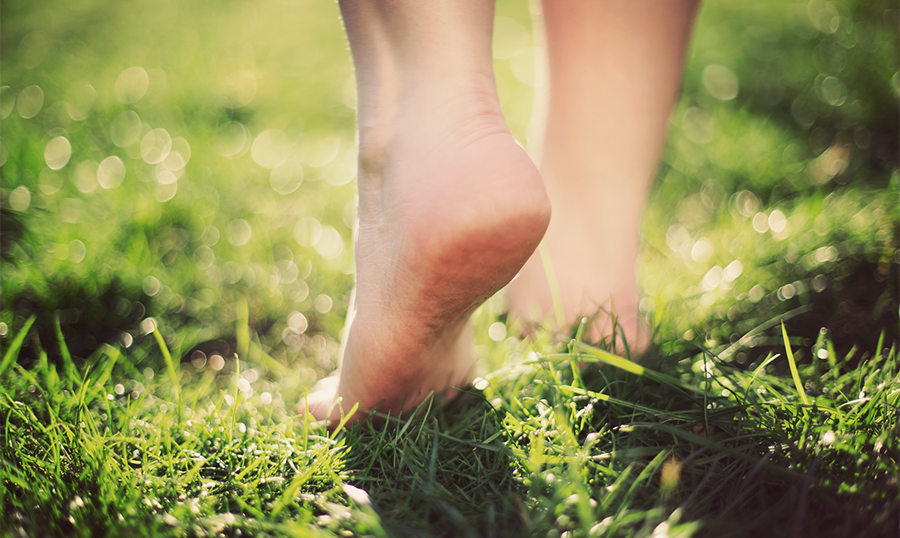The Case for Earthing: Is The Science Legit?

It sounds almost too simple to be real: take off your shoes, touch the ground, and feel better.
But emerging research on Earthing—direct contact with the Earth’s surface—suggests this ancient human habit may be one of the most overlooked wellness tools for modern [lon-jev-i-tee]nounLiving a long life; influenced by genetics, environment, and lifestyle.Learn More.
What Is Earthing?
Earthing (or grounding) reconnects the human body with the Earth’s natural electric charge. This can happen by walking barefoot on natural surfaces like grass, sand, or soil or by using grounding tools indoors, such as conductive mats or sheets that transfer the Earth’s electrons to the body.
Why should you try earthing? The current thinking is that because your body is an electrical system, re-establishing that electrical connection may influence markers of [in-fluh-mey-shuhn]nounYour body’s response to an illness, injury or something that doesn’t belong in your body (like germs or toxic chemicals).Learn More. Early research and small pilot studies have linked Earthing to changes in cardiovascular, metabolic, and immune function.
The Science of Earthing:
There have been a few small studies documenting measurable physiological changes in people when they are grounded. Here are four things that stood out:
1) Improved Sleep and Lower [kawr-tuh-sawl]nounA hormone that helps manage stress, energy, and alertness.Learn More
A review of studies published in the Journal of Environmental and Public Health cited a small study showing that people who slept grounded for six weeks showed normalized cortisol rhythms, reported falling asleep faster, and woke up less often during the night.
2) Less Inflammation and Pain
The same review included a small study that used imaging and delayed-onset muscle soreness (DOMS) trials, showing that Earthing reduced inflammation and accelerated recovery after physical strain.
3) Better [bluhd floh]nounThe movement of blood through the circulatory system, delivering oxygen and nutrients to organs and tissues to support energy, healing, and overall health.Learn More and Thinner Blood
A small study involving 10 people found that grounding reduced blood viscosity— a cardiovascular risk factor — improved red blood cell spacing and enhanced overall circulation, offering potential cardiovascular benefits.
4) Increased [vay-guhl tohn]nounThe health of the vagus nerve, which helps regulate stress.Learn More and Stress [ri-zil-yuhns]nounThe ability to recover quickly from stress or setbacks.Learn More
Another small study of infants grounded via small electrodes showed improved vagal tone (a key measure of autonomic nervous system health) within minutes, a promising sign for stress and inflammation regulation.
What to Know About Earthing Research
Most studies on Earthing show positive effects, but many have very small sample sizes, lack independent replication, or are conducted by researchers who advocate for the method. While the physiological shifts are intriguing, more large-scale, peer-reviewed trials are needed to confirm long-term benefits. Until then, think of Earthing as a low-risk wellness habit with emerging potential, not a medical treatment.
Want to Try Earthing?
Here’s how to start:
- Walk barefoot on natural surfaces (grass, sand, or dirt) for 10–20 minutes a day
- Sit or stretch out on grass or sand
- Use a grounding mat while you work, relax, or sleep indoors (Try the Hooga Grounding Mat)
We talk a lot about advanced wellness tools, wearables, blood tests, and cellular upgrades, but sometimes, simple interventions can cause the greatest shifts: in our habits, our mindset, and our well-being. Grounding may not be a magic bullet, but it’s a zero-cost, low-effort way to restore balance in a world filled with static
Try it: Step outside barefoot for 10 minutes a day. See how you feel. Write and let us know!
All featured products are selected independently and objectively by the editors. Super Age may receive a share of sales via affiliate links in content.
The information provided in this article is for educational and informational purposes only and is not intended as health, medical, or financial advice. Do not use this information to diagnose or treat any health condition. Always consult a qualified healthcare provider regarding any questions you may have about a medical condition or health objectives. Read our disclaimers.

